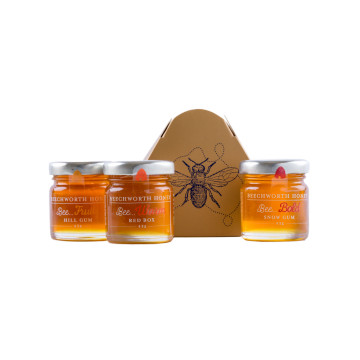The beekeeping season is almost done for another year…
With the glimpse of the first cooler nights in the North East of Victoria, we spy the end of the beekeeping season.
The beekeeping season is almost done for another year but look what its yielded…
Special 2019 Varietal Release – April 2019
Cool nights are a welcome relief for both us and our bees. We’re checking the bees now just to make sure all the hives have enough honey to last them through the winter. From here all the honey stays with the hive, ensuring the bees have good stores of honey to last the winter when it’s too cold to fly and the blossoms are long gone.
We turn now to ready ourselves for more jars of our 100% Australian honey to leave our doors as the cool weather seems to switch the nations eating habits to cooler weather breakfasts where more honey naturally pairs with warm porridge, crumpets and thick toast.
We get pretty passionate about the trees the bees gather honey from and to share this passion we’re proud to bring you some really special new honeys in our 2019 Special Varietal release. As the season unfolds I kept aside special lots of honey from trees we don’t see flower very often (or in this year’s case ever before) to produce honey.

Bee Hives
Each year thousands of beehives pollinate almonds and our family has been pollinating almonds for more than 50 years but never in that time have we known almond trees to yield nectar that the bees have produced honey from. I can’t help but wonder if this is also a result of our changing climate. Normally the bees are only there to move about the pollen (which produces the almond nuts) and we don’t get any honey. But this year one of our beekeepers seemed to be in just the right place, with just the right conditions and we have a tiny amount of really Limited Edition Almond Honey – it’s like no other honey I’ve ever tasted before, really different in both texture and flavour and I’m not giving any surprises away!
Blackberry is back and its mild fresh fruity flavour is always really popular. Our Blackberry fans who have been waiting so patiently for this honey to be produced will be pretty happy I expect.
Another particularly special honey we’ve managed to source is Scented Ash. The first thing you notice about Scented Ash is it’s amazingly light, floral aroma – it reminds me of lilac bushes in full bloom. Produced from a small rainforest tree in Northern Australia I think this has to be one of the most interesting and unique honey’s you will ever taste. We’ve produced, procured and packed a vast quantity of honey in our time but this is the first time we’ve ever seen and tasted Scented Ash. I’ve got my personal stash stockpiled so I can rotate this variety amongst my all time favourites. This tree only flowers spasmodically and so it’s really rare to get this honey.

Pilliga Box Forest NSW
From Queensland we go to outback NSW where the Pilliga Box grows. The Pilliga Forest also known as the “Pilliga Scrub” is home to the Pilliga Box. This is a 3000km square semi arid woodland of continuous remnant vegetation – the largest continuous remnant vegetation area in NSW just outside Dubbo in the Central West of the State. Pilliga is an Australian aboriginal name meaning “swamp oak”. Pilliga Box grows on the gentle slopes and plains on low-lying ground, preferring sandy loams and shallow soils with clay subsoils. The Pilliga is part of the traditional area of the Gamilaraay (also known as Gamilaroi or Gomeroi) people and contentious because of coal seam gas production. We paused and breathed in the Pilliga scrub this year in amongst one of the worst droughts on record. We wandered through the dry creek beds, camera in hand, ears and eyes wide open taking in small parts of this beautiful landscape. Parched soil, dry leaves on the ground beneath the canopy and enough of a pause to feel captivated by the mystique of this special bush. My curiosity for this tract of land and its flora has since been nourished by the ABC History Channel podcast “ Eric Rolls and the Pilliga Forest” – check it out. Eric Rolls wrote Australia’s first true environmental history of the Pilliga Forest – “A Million Wild Acres” from his first hand observations as a local farmer, researcher and naturalist. I reckon he’d be pleased that we were sharing this very special honey from his patch.
Get out amongst the trees, but if you can’t nourish your senses and your soul with the results of trees and bees. We hope you enjoy one of this year’s very special Limited release honey’s (click here to view the range)!
Go well, bee well!
Jodie





